
Human Anatomy & Physiology (11th Edition)
11th Edition
ISBN: 9780134580999
Author: Elaine N. Marieb, Katja N. Hoehn
Publisher: PEARSON
expand_more
expand_more
format_list_bulleted
Question
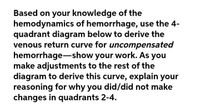
Transcribed Image Text:Based on your knowledge of the
hemodynamics of hemorrhage, use the 4-
quadrant diagram below to derive the
venous return curve for uncompensated
hemorrhage-show your work. As you
make adjustments to the rest of the
diagram to derive this curve, explain your
reasoning for why you did/did not make
changes in quadrants 2-4.
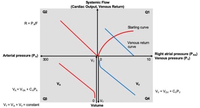
Transcribed Image Text:Systemic Flow
(Cardiac Output, Venous Return)
Q2
Q1
R= PF
Starling curve
Venous retun
curve
Arterial pressure (P)
300
Right atrial pressure (PRA)
10 Venous pressure (P)
V, 10
VA
VA =Voa + C,PA
Vy = Voy + C,P
Q4
V; = VA + V= constant
Volume
Expert Solution
This question has been solved!
Explore an expertly crafted, step-by-step solution for a thorough understanding of key concepts.
This is a popular solution
Trending nowThis is a popular solution!
Step by stepSolved in 2 steps with 1 images

Knowledge Booster
Similar questions
- Measuring a-vO2 difference is risky because Select 2 correct answer(s) Arteries have low pressure Venous blood has to be measured from the anatomic "mixing chamber" Venous blood has to be measured from the femoral vein Arteries have high pressurearrow_forwardWhich of the following approximate scenarios is INCORRECT with respect to blood flow? Question 31 options: Superior mesenteric v. > hepatic portal v. > capillary beds in the liver > hepatic v. > inferior vena cava Superior mesenteric a. > intestinal a. > capillary beds in the jejunum > superior mesenteric v. Abdominal aorta > renal a. > capillary beds in kidney > renal v. > inferior vena cava Abdominal aorta > testicular a. > capillary beds in the testis > testicular v. > superior vena cavaarrow_forwardfor its oxygen then it may die, forming rct. The severity of this condition depends on the precise location of the occlusion, which downstream tissues are involved, and how large an area of tissue dies. Use Figure 4.9 as a reference and list the flow of blood through both circuits in order, beginnng with the right atrium (don't forget to include the heart valves). 1. If an embolus breaks off in a systemic vein in the leg, it would be able to pass through: It would occlude: 2. If an embolus formed in the left ventricle, it would be able to pass through: 3. It would occlude: 4.arrow_forward
arrow_back_ios
arrow_forward_ios
Recommended textbooks for you
 Human Anatomy & Physiology (11th Edition)Anatomy and PhysiologyISBN:9780134580999Author:Elaine N. Marieb, Katja N. HoehnPublisher:PEARSON
Human Anatomy & Physiology (11th Edition)Anatomy and PhysiologyISBN:9780134580999Author:Elaine N. Marieb, Katja N. HoehnPublisher:PEARSON Anatomy & PhysiologyAnatomy and PhysiologyISBN:9781259398629Author:McKinley, Michael P., O'loughlin, Valerie Dean, Bidle, Theresa StouterPublisher:Mcgraw Hill Education,
Anatomy & PhysiologyAnatomy and PhysiologyISBN:9781259398629Author:McKinley, Michael P., O'loughlin, Valerie Dean, Bidle, Theresa StouterPublisher:Mcgraw Hill Education, Human AnatomyAnatomy and PhysiologyISBN:9780135168059Author:Marieb, Elaine Nicpon, Brady, Patricia, Mallatt, JonPublisher:Pearson Education, Inc.,
Human AnatomyAnatomy and PhysiologyISBN:9780135168059Author:Marieb, Elaine Nicpon, Brady, Patricia, Mallatt, JonPublisher:Pearson Education, Inc.,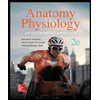 Anatomy & Physiology: An Integrative ApproachAnatomy and PhysiologyISBN:9780078024283Author:Michael McKinley Dr., Valerie O'Loughlin, Theresa BidlePublisher:McGraw-Hill Education
Anatomy & Physiology: An Integrative ApproachAnatomy and PhysiologyISBN:9780078024283Author:Michael McKinley Dr., Valerie O'Loughlin, Theresa BidlePublisher:McGraw-Hill Education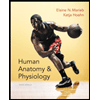 Human Anatomy & Physiology (Marieb, Human Anatomy...Anatomy and PhysiologyISBN:9780321927040Author:Elaine N. Marieb, Katja HoehnPublisher:PEARSON
Human Anatomy & Physiology (Marieb, Human Anatomy...Anatomy and PhysiologyISBN:9780321927040Author:Elaine N. Marieb, Katja HoehnPublisher:PEARSON

Human Anatomy & Physiology (11th Edition)
Anatomy and Physiology
ISBN:9780134580999
Author:Elaine N. Marieb, Katja N. Hoehn
Publisher:PEARSON

Anatomy & Physiology
Anatomy and Physiology
ISBN:9781259398629
Author:McKinley, Michael P., O'loughlin, Valerie Dean, Bidle, Theresa Stouter
Publisher:Mcgraw Hill Education,

Human Anatomy
Anatomy and Physiology
ISBN:9780135168059
Author:Marieb, Elaine Nicpon, Brady, Patricia, Mallatt, Jon
Publisher:Pearson Education, Inc.,

Anatomy & Physiology: An Integrative Approach
Anatomy and Physiology
ISBN:9780078024283
Author:Michael McKinley Dr., Valerie O'Loughlin, Theresa Bidle
Publisher:McGraw-Hill Education

Human Anatomy & Physiology (Marieb, Human Anatomy...
Anatomy and Physiology
ISBN:9780321927040
Author:Elaine N. Marieb, Katja Hoehn
Publisher:PEARSON